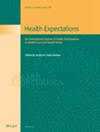Exploring the Role of Peer Health Navigators in the Australian Health System: A Qualitative Interview Study
Abstract
Background
Peer health navigators (PHNs) work with their own communities to provide health navigation support and connect with patients through shared experience and identity. The aim of this study was to explore the role of PHNs in the Australian health system from the perspective of managers and experts, with a focus on understanding how to build and sustain this workforce in Australia.
Methods
Individuals who employ and manage PHNs, as well as subject matter experts in the navigation field from a range of health and academic organisations across Australia, participated in semi-structured interviews. A descriptive qualitative approach based on naturalistic inquiry was used to analyse the interview data. Themes were framed around an adapted socio-ecological model using four levels: individual, interpersonal, organisational and societal (combined community and policy).
Results
Seventeen themes were identified within the four levels of the adapted socio-ecological model: individual (personal attributes, knowledge and skills, lived experience), interpersonal (boundary setting: professional, boundary setting: professional meets personal, boundary setting: self-care, supervision and debriefing), organisational (recruitment, qualifications and prerequisites, clear job description and expectations, training, role duties and tasks) and societal (value of peer navigators in Australia, government support, funding, strategic approach to workforce planning, workforce governance).
Conclusion
PHNs are a valuable part of the Australian health system. A cohesive, strategic, national approach is required to ensure the development of the workforce and the sustainability of programs and allow for navigators to be embedded within the Australian health system.
Patient or Public Contribution
This study is part of a larger project that developed formal education and training courseware materials for health navigators in Australia. The materials were co-designed with patients, managers and subject matter experts. In this paper, we sought the perspective from managers and experts across Australia who work with diverse groups of patients.


 求助内容:
求助内容: 应助结果提醒方式:
应助结果提醒方式:


